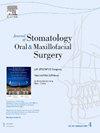Biomechanical evaluation of zygomatic-orbital-maxillary complex fractures following internal fixation
IF 2
3区 医学
Q2 DENTISTRY, ORAL SURGERY & MEDICINE
Journal of Stomatology Oral and Maxillofacial Surgery
Pub Date : 2025-10-01
DOI:10.1016/j.jormas.2025.102323
引用次数: 0
Abstract
Purpose
The aim of this study is to develop effective treatment strategies for zygomatic-orbital-maxillary complex (ZOMC) fractures using finite element analysis (FEA) and investigate the mechanical properties and stress distribution of different internal fixators.
Methods
A three-dimensional (3D) model was created from CT images of a patient with a unilateral ZOMC fracture, and the preinjury craniofacial structure was reconstructed. A cylindrical impactor was used to simulate facial impact. Biomechanical analysis was performed to assess the stability of internal fixation of the fracture lines at the frontal process of the zygomatic bone (FPZB), inferior orbital rim (IOR), and upper and lower parts of the zygomaticomaxillary suture (ZMS). The impact of different fixation methods on the anterior-inferior wall of the maxillary sinus (AIWMS) was also assessed in this study. A 120 N load was used to simulate physiological muscle force, and the maximum von Mises stress and maximum displacement for the fracture ends were assessed.
Results
The stress distribution on the impact model was similar to that on the patient's fracture lines, with all internal fixation devices experiencing maximum stress below the yield stress. The model exhibiting the largest displacement of the zygomatic body, IOR, and FPZB had not undergone internal fixation of the FPZB. The greatest maximum displacement value was recorded for the maxilla, at the non-fixed lower ZMS. The maximum displacement value was lower for 2 fixators placed at the AIWMS than for a single fixator placed at the fracture midline.
Conclusions
The placement of 2 internal fixators along the zygomaticomaxillary (NMB) and nasomaxillary buttresses (NMB) provides greater stability than the placement of a single device does. Moreover, stabilizing the fracture lines in the FPZB is essential, as doing so reduces the extent of displacement of free fracture ends by counteracting the masseter muscle force.
颧-眶-上颌复合骨折内固定后的生物力学评价。
目的:应用有限元分析(FEA)探讨颧骨-眶-上颌复合体(ZOMC)骨折的有效治疗策略,并研究不同内固定物的力学性能和应力分布。方法:对单侧ZOMC骨折患者的CT图像建立三维(3D)模型,重建损伤前颅面结构。使用圆柱形冲击器模拟面部冲击。采用生物力学分析评估颧骨额突(FPZB)、下眶缘(IOR)和颧腋缝(ZMS)上下部分骨折线内固定的稳定性。本研究还评估了不同固定方法对上颌窦前下壁的影响。采用120 N载荷模拟生理肌肉力,评估骨折端最大von Mises应力和最大位移。结果:冲击模型上的应力分布与患者骨折线上的应力分布相似,所有内固定装置的最大应力均低于屈服应力。颧骨体、IOR和FPZB位移最大的模型未进行FPZB内固定。在非固定下ZMS处,记录了上颌骨的最大位移值。在AIWMS处放置2个固定架的最大位移值低于在骨折中线处放置单个固定架的最大位移值。结论:沿颧腋扶壁和鼻上颌扶壁放置2个内固定架比放置单个内固定架更稳定。此外,稳定FPZB的骨折线至关重要,因为这样做可以通过抵消咬肌的力量来减少自由骨折末端的位移程度。
本文章由计算机程序翻译,如有差异,请以英文原文为准。
求助全文
约1分钟内获得全文
求助全文
来源期刊

Journal of Stomatology Oral and Maxillofacial Surgery
Surgery, Dentistry, Oral Surgery and Medicine, Otorhinolaryngology and Facial Plastic Surgery
CiteScore
2.30
自引率
9.10%
发文量
0
审稿时长
23 days
 求助内容:
求助内容: 应助结果提醒方式:
应助结果提醒方式:


